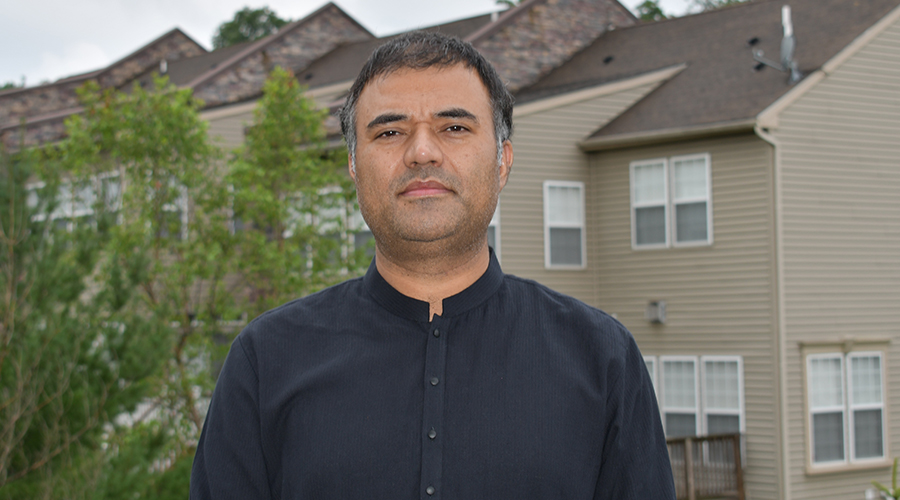
When Inam Ur-Rahman (Master of Environmental Studies `19) began the Master of Environmental Studies (MES) program, he wished to learn more about sustainability. “I have a thirst for knowledge,” says Inam. “Whatever I learn, it motivates me to learn something else.” An engineer with professional experience in semiconductor equipment manufacturing and aerospace industries, Inam studied Organizational Dynamics to learn about change management, systems thinking, project and program leadership, coaching, global supply chains, and sustainable development. In the course of his studies, he became interested in sustainability. “I always thought that I was a big picture person, but looking back, my focus was only on organizations—and, in the MES program, I realized that organizations were operating in the larger context of the environment,” he reflects. “My interest in sustainability led me to the MES program, and in this program, I discovered my passion.”
In the MES program, Inam took courses without interrupting his full-time career and developed his knowledge of environmental issues at global, regional, and local scales. “I was able to take courses that showed the larger impact of climate change on the planet and how it would impact the global population in the next 50-70 years. To learn about the impacts of climate change at regional and local scales, I also took courses that showed me how energy, water, land, and forests were all connected,” he recalls. In addition to what he studied, there were field trips to explore urban forests and land conservation around Philadelphia. “We would go to different sites and see plants, trees, and birds, and our instructors would have so much information about everything we could see around,” he recalls. “As an engineer, I did not have a background in identifying trees or birds. But if you are with a teacher who motivates you to learn what is around you, you start to see the big picture, you start to pay attention to how everything is connected to everything else.”
During his time in the program, Inam discovered his passion for urban sustainability. “There is a real opportunity in managing and designing better cities,” he says: About 50-60% of the present global population lives in cities, and some estimates predict that 80-85% of the global population will reside in cities by the end of this century. “To continue to survive on this planet, and to maintain the health of our societies, economies, and ecosystems, it is essential that our cities are sustainably managed,” says Inam. “If we don’t manage your cities well, we’re impacting our own existence.”
Inam focused on the Randstad region in the Netherlands for his capstone project, a study in sustainable and resilient urban development. “The Netherlands is using a weakness as its strength,” he explains. “Some of their cities are 18-20 feet below sea level and continue to exist right next to the sea. But the Netherlands has learned to live with this vulnerability and has invented technology to keep their cities safe and dry. A key lesson in my capstone is that, with attention and dedication, you can make a problem into an opportunity and a weakness into a strength.” Inam applies the same engineering mindset when considering where he might turn next in his pursuit of urban sustainability. “In North America and Europe, most of the cities’ infrastructure is in place—and aging. Here mainly are opportunities to upgrade or maintain the infrastructure,” he says. “But in Asia and Africa, there is a lot of urban growth, but most of the infrastructure they will need in the next 50 years is yet to be built. That is the opportunity space.”
After completing the MES degree, Inam pursued a Master of Science in Sustainable Urban Development at the University of Oxford. Currently, he is completing his thesis on a particular aspect of urban life that has both social and environmental impacts: commuting to work, a routine that changed drastically for him when he moved to the West Coast. “In San Francisco Bay Area, it’s normal to spend two hours on the road in the morning and two hours on the road in the evening. When I was in Philly, the max commute I experienced was 30 minutes,” he explains. Shocked by the abrupt change in lifestyle, he turned this challenge into his next research project. “The simple act of a commute has so many implications for urban living: affordable housing, proximity to workplace, roadside safety, personal well-being, anxiety and stress resulting from traffic delays and congestion, and little time to spend with family. The list of how commuting impacts people, environment, and cities is long.”
“My experience in the MES program changed the direction of my life. My intention is now to work in areas of urban development,” concludes Inam, who has his sights set on a career path that will bring his engineering and environmental expertise together. “All my life, I was focused on improving products and organizations. During the MES program, I found that if I focused on sustainability in cities, I could make a bigger impact.”





